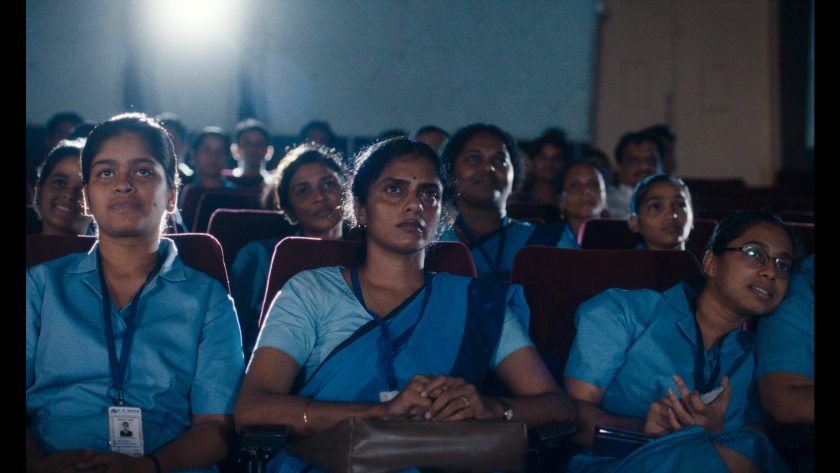In A Nutshell: A stunning exploration of life and the search for connection against the backdrop of a developing country.
Aftertaste: Tastes like, or rather retains, the texture and sensation of an ice cube slowly melting in one’s mouth.
Whose Cup of Tea?: Soft yet utterly life-affirming, All We Imagine as Light is a film for people who enjoy slow, dreamlike cinema with a deceptive emotional impact.
__
Payal Kapadia’s exquisite narrative debut, All We Imagine as Light, achieves something truly spectacular: capturing the genuine texture of a place while allowing it to transcend into fiction. Prosaic, gentle, and rich with detail, the film is singular in its portrayal of Mumbai’s vast metropolitan sprawl. Watching the opening sequence, which weaves through the city’s meandering roads and cracked, crowded sidewalks under the glow of florescent street lights, felt like coming home. Sitting there in the Royal Festival Hall, my memories of the city slowly melded into the images on the screen, and for the first time, I saw a version of Mumbai that, until last night, only existed in my mind’s eye.
Earlier this year, All We Imagine as Light won the Grand Prix at the Cannes Film Festival, where it was the first Indian film to be selected for Official Competition in nearly three decades. Kapadia, who made history as the first female Indian filmmaker to win at the festival, established a vision distinct from the country’s contemporary cinematic landscape. The various narratives, through lines and dream-like soliloquies, stippled throughout All We Imagine as Light, felt like things I overheard growing up in Mumbai. With unflinching sensitivity, the film weaves a rich tapestry of stories often relegated to the margins of the mainstream, tracing the experiences of three women, Prabha, Anu and Parvati, as they navigate their internal lives, relationships and external realities.
Kapadia’s meditative pacing and cinematic agility illuminate the beauty and complexity in the undertone of everyday life. As well as the interactions between characters and the physical and temporal spaces they inhabit. To be in Mumbai is to hear it, a quality the film reconstructs with immersive detail, from the constant barrage of construction and conversation to the muffled downpour of Monsoon rain beneath umbrellas and beyond window panes. In All We Imagine as Light, the emotional intricacies of its characters’ lives are thoroughly felt against the heady atmosphere of a relentlessly expanding city. Although I am only twenty years old, I’ve witnessed my home evolve drastically, especially in the last decade, to the extent that the city of my childhood is a distant memory from the one I return to come the winter holidays. I recall driving into South Bombay as a little girl and my father imploring my brother and me to pay attention to what we saw because everything would be different in a year’s time. All We Imagine as Light pays attention, functioning as a valuable cultural document of life in Mumbai before this iteration of the city also fades into history.
Like the landscape they traverse, the film’s three leads are caught at the intersection of desire and reality. Longing for freedom, opportunity, and a more expansive life, they find themselves in limbo between what is and what can be. However, sentiments of hope and heartache are central to the backdrop against which All We Imagine as Light unfolds. Halfway through the film, before the story migrates to Parvati’s village down south, Prabha describes Mumbai as “a city of illusions”, a fitting yet melancholic assessment. Mumbai is a hopelessly aspirational place, unsure of what it is yet relentlessly pursuing what it thinks it can be. However, like in any developing country, those whose land and labour are sacrificed to bring these dreams of development into existence are often left behind by the future they helped build. Kapadia’s empathetic exploration of working-class Indian life and her necessary, biting critique of the country’s expanding wealth gap are articulated by mesmerising, lived-in performances. The three women at the film’s beating heart seemed extraordinarily familiar: they were faces I had seen before in domestic kitchens and behind countertops, perhaps passing me on the street or fleetingly through open car windows. In India’s decidedly patriarchal cinematic landscape, which often fails to endow women with the same interiority and nuance awarded to the male experience, seeing complex depictions of female desire and friendship was a joyous, cathartic experience.
A highlight from this year’s festival, All We Imagine as Light, is a powerful, lyrical film quite unlike anything I have seen, especially regarding representations of India on screen. Walking back across the water after the screening, I felt raw and elated, and for the first time in a long time, I missed home.




